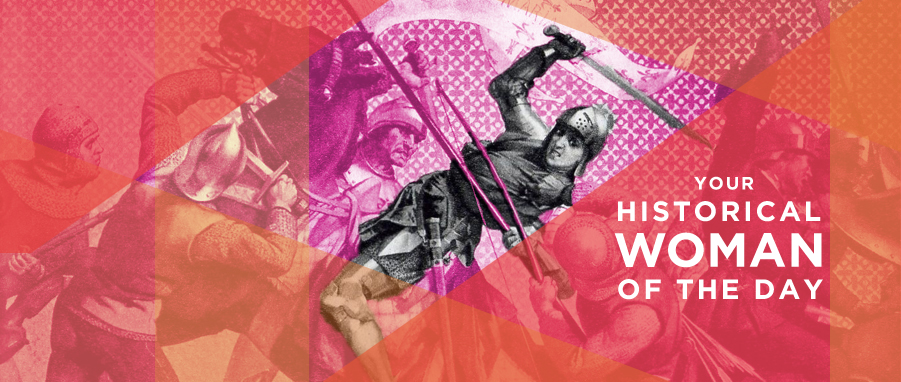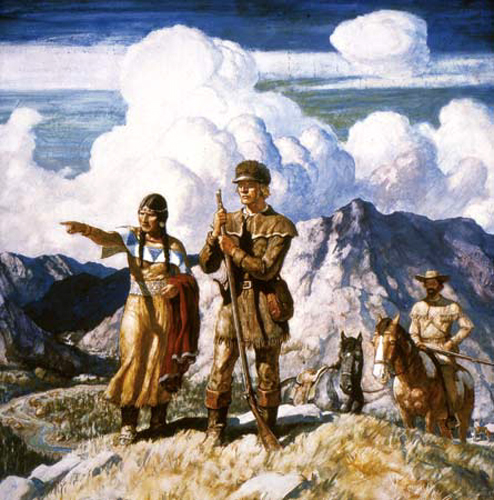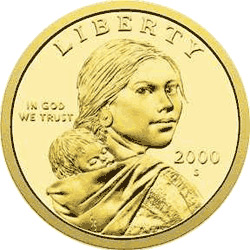She adorns our dollar coins and she makes a cameo in almost every fifth-grade textbook, but how much do you really know about Sacagawea?
If you’re like me, not that much. It’s all very gratifying to imagine the stalwart Native American guide for the Lewis & Clark expedition leading her white hosts over mountains and across rivers, all while carting a small baby on her back in a leather baby-sack; but the real story is both less romantic and potentially more impressive.
Sacagawea was born to a Shoshone tribe in present-day Idaho around 1788, just a few years after a certain British colony had gained independence on the other side of the continent. When she was 11 or 12, a battle with the Hidatsa Indians resulted in Sacagawea’s capture and transport to what is now North Dakota.
It was here that young Sacagawea met the man who would be her husband—one Toussaint Charbonneau, a Quebecois fur trapper who was living amongst the Hidatsa tribe. I can just picture the bearded man’s man, covered in mangy fox fur, courting the thirteen-year-old (yuck) Shoshone transplant in the snowy wastelands of North Dakota. Let’s be honest. No one will ever make a love story out of it.
A few years later, two dudes named Lewis and Clark were on their way to chart the newly-purchased Louisiana Territory, of Louisiana Purchase fame, and they enlisted Charbonneau to help guide and interpret. Sacagawea was an added bonus: since they would largely be passing through Shoshone territory (oops---I mean America), her expertise in that language was an asset.
The romantic images of Sacagawea summiting mountain crests, arm outstretched to beckon a weary but bright-eyed Lewis and Clark into the next gleaming American valley, are kind of, well, idealized. Surprising, I know. In reality, Sacagawea served as more of an interpreter than an actual guide, and Lewis and Clark frequently make reference to her as “the squar [squaw],” “the wife of Charbonneau,” and, inexplicably, “Janey.” Ever so occasionally, by her actual name (or more, their best approximation of it).
At one point, the expedition nearly lost a boatload of letters and other important crap that Lewis and Clark were toting around. Sacagawea speedily retrieved the items before they sank or were swept away; and in gratitude, the pair named the waterway the Sacagawea River.
Which kinda seems like a really typical Lewis/Clark move to pull, if you know what I mean. “Oh geez, thanks, Sacagawea! . . . You know what I’m gonna do? This river? I’m gonna name it after you. There. It’s been named. I’ve decreed it. From now on, everyone will call this the Sacagawea River. Okay, let’s keep moving. Keep up.”
Which she did, even with a baby on her back. The baby, Jean Baptiste, was a big hit with the guys. Clark liked the little guy so much that, it seems, years later, after Sacagawea’s death, he adopted him. (Toussaint was still alive, but probably kind of a deadbeat, anyway.)
While Sacagawea’s role in the Lewis and Clark expedition can be overstated, it doesn’t diminish the significance of what she did. Her knowledge opened up new frontiers to the American explorers, and she was hence able to practice an autonomy and freedom of movement unknown to most other American or native women of her time. It’s been speculated that another of her important roles in the expedition was to serve as a symbol of peace—most native groups understood that the presence of a woman in a party meant there were no intentions of war. (Which in and of itself is an interesting kind of powerful not-power. For more on this, read Juliana Barr’s excellent Peace Came in the Form of a Woman.)
In the end we all know very little about Sacagawea, the person. The images that adorn our statues and our numismatics are based on the faces of more contemporary Shoshone women, as no likenesses of S herself have survived the centuries. We don’t even know when she died---while most believe she died in 1812, just a few years after the expedition, some think she actually lived to a ripe old age and eventually returned to her people in Idaho.
But who needs an accurate likeness or a detailed minutiae of her life? What we can say, is. . . the fact that she’s remembered so well when almost all we have to go off of are some scant, fairly dismissive mentions in the journals of two important men, means she’s a pretty damn important woman. That’s only logical.



